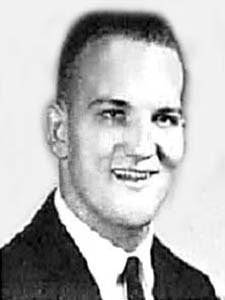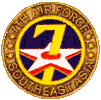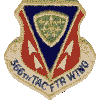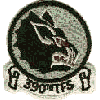| |
|
|
|
Douglas Craig Condit
Major
390TH TAC FTR SQDN, 366TH TAC FTR WING, 7TH AF United States Air Force Forest Grove, Oregon February 05, 1942 to May 22, 1979 (Incident Date November 26, 1967) DOUGLAS C CONDIT is on the Wall at Panel 30E, Line 89 See the full profile or name rubbing for Douglas Condit |
  |

|



| |
|
In a series of letters and tapes home, Lt. James Badley talked about a series of losses experienced by the 366th Tactical Fighter Wing during November of 1967. Douglas Condit (he graduated from Oregon State University with Jim Badley) and Herbert Brennan's aircraft was the last in that series. On 9 November 1967 a 480th Tac Ftr Sqdn F-4C (tail number 64-0751) crewed by Lt. Colonel John Armstrong and Lt. Lance Sijan went down near Ban Loboy Ford, Laos, as they bombed enemy supply routes. The circumstances indicated that the destruction of the aircraft could have happened in one of two ways: they could have taken a direct hit or the plane could have been blown up by its own bombs. Since Armstrong's flight was armed with the new FMU-35 time-delay fuzes, there was a distinct possibility that they had malfunctioned. Faulty fuzes could have prematurely triggered detonation of all six bombs, and if this had happened, over two tons of high explosive would have erupted less than fifty feet from the airplane. The next day, 10 Nov 1967, Lt. Colonel Kelly Cook told his wife in a letter that part of his flight assignment that night was to check out some malfunctioning bomb fuzes. Cook's flight that night consisted of two aircraft from the 389th Tac Ftr Sqdn:
When mechanically-fuzed bombs were released, the arming wire was pulled and a front spinner propeller began to spin. After the spinner rotated a certain number of revolutions -- set during ground weapons load -- the bomb's fuze was active and ready to detonate upon ground impact. The new FMU-35s, chemical fuzes developed for use on mines and delayed bombs, armed the bomb through a precisely-timed, two-step process: First, the bomb was released from the aircraft; this act pulled an arming wire, which then allowed the second step to begin. During the second step, chemicals began eating through a thin metal shield. When the shield was broached, the bomb was an armed mine: volatile and very sensitive to impact. Unfortunately, as they were to prove months later, there was a defect in the fuzes when the military first began using them, and, essentially, the bombs were arming when they were attached to the aircraft. This meant the bombs were live and deadly when released from the aircraft, allowing premature, sometimes immediate, detonation. Colonel Frederick "Boots" Blesse, Deputy Commander of Operations for the wing, suspected the fuzes were defective after the back-to-back losses of Armstrong/Sijan and Baffle Flight. At that time, he ordered all the FMU-35 fuzes removed and replaced with regular mechanical fuzes. Unfortunately, 7th Air Force didn't agree with Colonel Blesse's conclusion that the FMU-35 fuzes were at fault and he was ordered to continue using the FMU-35s. On 26 November 1967, Colonel Brennan and Lt Condit went down in Laos (F-4C 64-0697, 390th TFS). It seemed to be a repeat performance of the Armstrong/Sijan loss two weeks earlier. They had rolled in on the target, released their bombs, and had immediately blown up. Colonel Blesse immediately suspended all use of the FMU-35 fuzed weapons until a thorough investigation could be conducted. This time 7th Air Force listened and responded by sending U.S. Air Force Contractor personnel to DaNang to officially investigate the fuze problem. This official delegation couldn't find anything wrong with the fuzes and delivery of weapons employing this fuze was began again at the end of December. Two weeks later, on 16 January 1968, Colonel Blesse's suspicions were finally confirmed. Two F-4s from the 480th TFS were tasked with a SKYSPOT mission using FMU-35 fuzed 750 pound Mk 117 bombs set for delayed detonations from 45 minutes to six hours after arming. The mission crews were
After returning to the base, Lewis and Kelley told how one of their bombs exploded below and behind their right wing. They saw the flash of light, felt the push on the aircraft, heard the noise, and saw 1/3 of their right wing being blown in pieces up and slightly to the left. That information was all Blesse needed -- he ordered the armament people to use the fuzes, but to leave them disconnected from the bombs. From that time forward, there were no more incidents at DaNang of aircraft suddenly blowing up upon release of their FMU-35 fuzed bombs. Twenty years later, I wrote about this series of losses in my book Angels Unknown, which documents James Badley's tour of duty at DaNang Air Base. The information I obtained from the Defense Department described Douglas Condit's last flight in this way: In his book Check Six, A Fighter Pilot Looks Back, Major General Frederick "Boots" Blesse states that neither Herbert "Bert" Brennan nor Doug Condit ever activated their survival radios - there were no beepers heard following their crash or during the next four days when the wing flew search and rescue missions over the crash site. After reading this, I wrote to General Blesse and asked him why his account differed from the official report. Since Blesse was Deputy Commander of Operations for the wing at that time, I assumed he would have been apprised of every detail surrounding that flight. His letter dated March 19, 1991, said:
From the friend of a friend, |
|
I just wanted to tell my story of why I followed Douglas C. Condit's 'missing' story since my birthday of November 26, 1967. My grandmother (now deceased) gave me a POW bracelet for my birthday; imagine how surprised I was when the date on the bracelet was the same as my birthday. I was so stunned - vowed to find this person if it took me the rest of my life. Every place I've lived (moved 52 times in my life; 10 states), I'd call every Condit name in the phone book. Years after the incident, I located an address so I could write for a status on Captain Condit. Every year I also wrote, telling the government agency that handled that effort (I've forgotten the address now) my goal. How really incredible and profound it was when the big envelope arrived on my 1992 birthday (November 26) - inside was all the data and I was so sorry to learn he hadn't come home, but instead had lost his life. Thanks to a lovely lady named 'Lynda' who read my postings on websites (in my continued effort to find out where his actual final burial site was), who was kind enough to send me this particular website and has offered to share the brother's address for Captain (Major) Condit so at the age of 64 (my birthday is November 26, so this time it seems it's an early birthday gift), I'll finally reach my goal of not only locating this man, but finally sending a personal letter to his brother and family (I do believe I learned the father has died and is laid to rest next to his son, Douglas). It takes many people CARING to make such 'magic' and 'miracles' happen as it seems to me has happened this evening. A trite bit of happiness (for me) was this past week-end when my Detroit Tigers took the American League Pennant after 22 years of not doing so. Another more serious bit of happiness came when my son who has a home in the Columbus area where a tornado also hit this past week-end was spared damage and harm. We seem to have these little miracles of great incidence and value; we have other 'happy times' like a favorite sports team working together, to make a 'winning situation'. Still, it was a TEAM effort for the Tigers to realize their dream this year. It has been a TEAM effort for OUR MILITARY FOR SO MANY YEARS. WE SHOULDN'T MENTION THEM BECAUSE IT'S SAD TO THINK WARS ARE STILL GOING ON AFTER SO MANY LIVES HAVE ALREADY BEEN LOST! So, in closing and in recognition of a young man who's a friend of ours - now serving in Iraq (Lt. Daniel Britt), for my son's brother-in-law who just returned after a safe '1-year' effort in Iraq (he's in the Marine Corps), I wanted to add my posting. Also, in honor of my husband who came home after two tours of duty in Viet Nam, awarded a number of medals - including the Distinguished Flying Cross Award, we both are delighted that these names we've seen on this website; the efforts of ALL OF YOU INVOLVED, and the caring public/citizens/patriots (just like Lynda) are the 'type of 'guiding light' that keeps our own personal spirit of caring for our fellow-countrymen and military, burning. It's nice to know if we should 'burn a little bit low', someone like Lynda will 'spark' it up with a kind e-mail as I received a few days ago - again, this evening. I think we all at times need to remember how necessary it is to do our 'small part' by lighting the world. I think the many 'one little candles' on this website have proven it is definitely a 'bright world'. Thank you for letting me visit this spot.
Diane Stirling-Stevens |
| Contact Us | © Copyright 1997-2019 www.VirtualWall.org, Ltd ®(TM) | Last update 08/15/2019. |